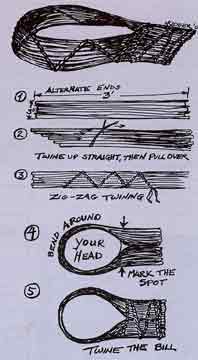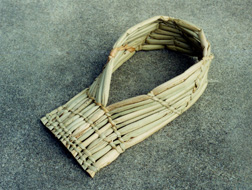
This simple sun visor is based on an example attributed to
the Klamath Indians of Northern California. It can be made from
green tule reeds (also called bulrushes) for temporary use or
with dried and re-soaked tule for long term use. The twining can
be done with either split tule or cattail leaf. If doing a quick
version in the field, try to find cattail or tule that has been
naturally cut and dried to at least a yellow color as it will
be more pliable.

Begin twining at least 8 inches from the ends of the tules. Twining begins by twisting up a split, soaked tule, then bending it around the first tule ribs (not in the center). After a half twist, add in the next rib and so on until about 3 inches have been incorporated. This twining should be done so as to angle through the ribs as shown. You know the twining is correct if the two twiners alternate into the up position, and also twist around each other. This project may work even if you do it wrong.
Wrap the twined tule band around your head so that it forms a bill with the beginning of the twining on one side and the end of the zig-zag on the other. Holding it together at this point, twine all the way across both halves of the bill. Recheck the fit, adjusting as necessary and then twine more rows until the bill has been completed. Finish with a tight double row and tie off the ends. Now wear it proudly.

Tule visor made by Dino Labiste.
This article was first published in The
Bulletin of Primitive Technology (Spring 2000, #19)
E-mail your comments to "Norm Kidder " at atlatl1@aol.com
We hope the information on the PrimitiveWays website is both instructional and enjoyable. Understand that no warranty or guarantee is included. We expect adults to act responsibly and children to be supervised by a responsible adult. If you use the information on this site to create your own projects or if you try techniques described on PrimitiveWays, behave in accordance with applicable laws, and think about the sustainability of natural resources. Using tools or techniques described on PrimitiveWays can be dangerous with exposure to heavy, sharp or pointed objects, fire, stone tools and hazards present in outdoor settings. Without proper care and caution, or if done incorrectly, there is a risk of property damage, personal injury or even death. So, be advised: Anyone using any information provided on the PrimitiveWays website assumes responsibility for using proper care and caution to protect property, the life, health and safety of himself or herself and all others. He or she expressly assumes all risk of harm or damage to all persons or property proximately caused by the use of this information.
© PrimitiveWays 2013